Zoom
Trash
Related: know about world
- How it works
- Science Resources
- Basics/ Knowledge
- DNL
- makake
- Education
- Enterprise

Vous ne verrez pas leurs noms dans les manuels scolaires... Et pourtant, ces 10 femmes ont révolutionné le monde des sciences ! Voici 10 femmes qui ont contribué, de manière significative, à l'avancée de la science. Pourtant, elles sont encore largement méconnues. Certaines n'ont pas pu bénéficier de la reconnaissance de leurs confrères masculins, d'autres se sont tout bonnement fait "voler" leur travail... Nous avons voulu leur rendre cet hommage, afin qu'elles soient connues à leur juste valeur. 1. Mary Anning (1799-1847) : Personnage fondateur de la paléontologie moderne, a découvert plusieurs espèces de dinosaures et ébranlé les thèses créationnistes. Mary Anning est née dans un petit village du sud de l’Angleterre. Petit à petit, la recherche de fossiles se professionnalise, Mary ne vend plus ses fossiles aux touristes : ses principaux clients sont des scientifiques, ce qui fait d’elle une des toutes premières paléontologues.
Tous les fossiles qu’elle trouve sont récupérés par des scientifiques afin d’être étudiés. 2. 3. . (1878-1968) : Physicienne, a découvert la fission nucléaire. 4. 5. 6. 7. 8. 9. 10. The quiet revolutionary: How the co-discovery of CRISPR explosively changed Emmanuelle Charpentier’s life. Peter Steffen/DPA/PA Emmanuelle Charpentier: a key inventor of the gene-editing technology CRISPR–Cas9.
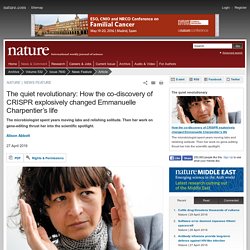
Emmanuelle Charpentier's office is bare, save for her computer. Her pictures, still encased in bubble wrap, are stacked in one corner, and unpacked cardboard boxes stuffed with books and papers are lined up in the adjacent room. But across the corridor, her laboratory is buzzing with activity. When Charpentier moved to Berlin six months ago, she had her science up and running within weeks, but decided that the rest could wait. Charpentier's workspace is a fitting reflection of her scientific life — one in which she always seems to be moving while keeping science on the go. The itinerant lifestyle doesn't seem to have hampered the microbiologist as she has carefully dissected the systems by which bacteria control their genomes.
Colleagues who know Charpentier well describe her as intense, modest and driven. Her years at the Pasteur Institute were formative. Stephen Lam/Reuters. Those Who Dared To Discover: 15 Women Scientists You Should Know. Chien-Shiung Wu (1912 - 1997) Chien-Shiung Wu was born in China, but at the recommendation of one of her supervisors, she set off for the US in 1936 to attend the University of Michigan for her Ph.D in nuclear physics.
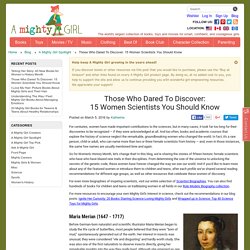
However, when she learned that women weren’t allowed to use the front entrance at Michigan, she changed her plans and attended University of California, Berkeley instead. As a part of the Manhattan Project during WWII, she helped develop the process for separating uranium metal into various isotopes. She is best known for conducting the Wu Experiment, which disproved a hypothetical physical law called the conservation of parity; her experiment paved the way for several of her colleagues to win the 1957 Nobel Prize in physics, although the Nobel Committee overlooked her contributions.
Related Resources. Nine Outstanding Women Working In Science And Technology. Worldwide, only 28 percent of the researchers in science, technology, engineering and math (STEM) are women.
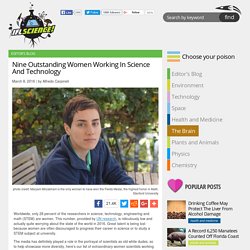
This number, provided by UN research, is ridiculously low and actually quite worrying about the state of the world in 2016. Great talent is being lost because women are often discouraged to progress their career in science or to study a STEM subject at university. The media has definitely played a role in the portrayal of scientists as old white dudes, so to help showcase more diversity, here’s our list of extraordinary women scientists working today as we celebrate International Women's Day. The list is definitely not exhaustive, but we believe it is representative of the incredible pool of talent found in every scientific discipline. Fabiola Gianotti Portrait of Fabiola Gianotti taken when she was a spokesperson for the ATLAS experiment.
Italian particle physicist Dr. Margaret Hamilton Margaret Hamilton, lead Apollo flight software engineer, in the Apollo Command Module. Dr. Dr. Women under-represented in world’s science academies. TREND WATCH The first global survey of women’s representation at the highest level of academia shows that less than one-eighth of the members of science academies around the world are women.
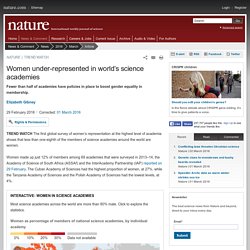
Women made up just 12% of members among 69 academies that were surveyed in 2013–14, the Academy of Science of South Africa (ASSAf) and the InterAcademy Partnership (IAP) reported on 29 February. The Cuban Academy of Sciences had the highest proportion of women, at 27%, while the Tanzania Academy of Sciences and the Polish Academy of Sciences had the lowest levels, at 4%. Women’s under-representation in academies matters because the organizations act as sources of both role models and science-policy advice, says Dorothy Ngila, who coordinated the study at ASSAf. “They should make sure their panels and reports are reflective of the diversity of our world,” she says. “You cannot provide advice to government using only half the team.” ADN : une nouvelle méthode de séquençage au potentiel "considérable"
Séquencer l'ADN en dix minutes au lieu des trois à quatre heures habituelles : le Toulousain Aurélien Bancaud, chargé de recherche au CNRS, vient d'être primé pour une découverte au potentiel "considérable", allant de la criminologie aux tests de dépistage du cancer.
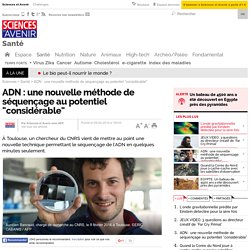
"C'était un peu de la chance" : comme souvent dans le monde des innovations, celle d'Aurélien Bancaud a été fortuite. Le chercheur du Laboratoire d'analyse et d'architecture des systèmes du CNRS (LAAS-CNRS) tentait en 2012 de ralentir l'écoulement de produit dans un ADN, afin de pouvoir lire un séquençage, en utilisant un champ électrique. "On a alors vu que ce champ électrique séparait l'ADN, sans besoin de matrice", explique le chercheur, qui vient de recevoir pour cette découverte le premier prix d'instrumentation de la Société française de chimie. Des laboratoires sur puce plus sensibles. Science Knowledge Quiz. Male Scientists' Biographies Written As If They Were Women.